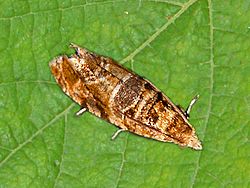European grapevine moth facts for kids
Lobesia botrana, also known as the European grapevine moth or European grape worm, is a small moth. It belongs to the family Tortricidae. This moth is known for causing damage to grapevines.
Quick facts for kids European grapevine moth |
|
|---|---|
 |
|
| Adult of Lobesia botrana | |
| Scientific classification | |
| Kingdom: | |
| Phylum: | |
| Class: | |
| Order: | |
| Division: | |
| Section: |
Cossina
|
| Family: | |
| Subfamily: |
Olethreutinae
|
| Genus: |
Lobesia
|
| Subgenus: |
Lobesia
|
| Species: |
L. botrana
|
| Binomial name | |
| Lobesia botrana ([ Denis & Schiffermüller, 1775])
|
|
| Synonyms | |
|
|
Contents
Where the European Grapevine Moth Lives
This moth originally comes from Southern Italy. You can find it naturally in places like Southern Europe, North Africa, Anatolia (which is part of Turkey), and the Caucasus region.
Recently, this moth has traveled to new countries. It has been found in Japan, Chile, and Argentina. However, on July 5, 2021, a food safety group in Argentina announced that the moth had been completely removed from two areas there: Cafayate and Concordia.
What the European Grapevine Moth Looks Like
The adult European grapevine moth is quite small. It can grow to be about 6 to 8 millimeters (about 0.2 to 0.3 inches) long. Its wingspan, which is the distance from one wingtip to the other when its wings are spread, is usually 12 to 13 millimeters (about 0.5 inches). Female moths are usually a little bit bigger than males.
The front wings of the moth have a mix of colors. They are mottled with tan-brown, greyish, and dark-brown patches. The back wings are gray and have a fringe-like border.
The larvae, which are the young caterpillars of the moth, are also small. They can grow to be about 8 to 9 millimeters (about 0.3 to 0.35 inches) long. They are usually yellowish-green to light brown, and their heads are a light yellow color.
Life Cycle and Habits of the Moth
The young moths, called larvae, mostly eat the flowers and fruits of grapevines (Vitis vinifera). They also feed on a plant called spurge laurel (Daphne gnidium). However, they have been seen eating other plants too. These include blackberry (Rubus fruticosus), currants (Ribes species), olives (Olea europaea), sweet cherries (Prunus avium), plums (Prunus domestica), kiwifruit (Actinidia chinensis), and pomegranates (Punica granatum).
In Europe, the European grapevine moth usually has two or three generations each year. This means they complete their life cycle from egg to adult two or three times. The larvae take about 20 to 30 days to grow. When winter comes, the pupae (the stage between larva and adult) stay safe inside a silken cocoon until spring.
This moth is a big problem for vineyards where grapes are grown. The larvae are known to feed inside the grapes. They hollow out the fruit and leave behind their waste, which can ruin the grape harvest.
The European Grapevine Moth as an Invasive Species
An invasive species is a plant or animal that is brought to a new place and causes harm to the environment, economy, or human health. The European grapevine moth became an invasive species in the United States.
In September 2009, this moth was found in the Napa Valley in California. This was the first time it had ever been seen in the United States. After this discovery, officials set up more traps and surveys. They found the pest in several other places in the county.
On March 9, 2010, the California Department of Food and Agriculture (CDFA) announced a quarantine. A quarantine is like a strict rule that stops things from moving in or out of an area. This quarantine covered about 162 square miles (420 square kilometers). It included parts of Napa, Sonoma, and Solano counties. This rule affected how host plants (plants the moth eats) could be moved from the infested area.
By May 12, 2010, Fresno County was also put under quarantine. This happened after two moths were found near Kingsburg, California. Mexico also told the United States Department of Agriculture (USDA) that they would not accept fruit from Fresno County. This had a big impact on California's stone fruit and grape exports.
However, there's good news! By August 2016, no moths had been found in California since June 2014. Because of this, the state declared that Napa County, and all of California, were free of this invasive species.
See also
 In Spanish: Polilla del racimo para niños
In Spanish: Polilla del racimo para niños

